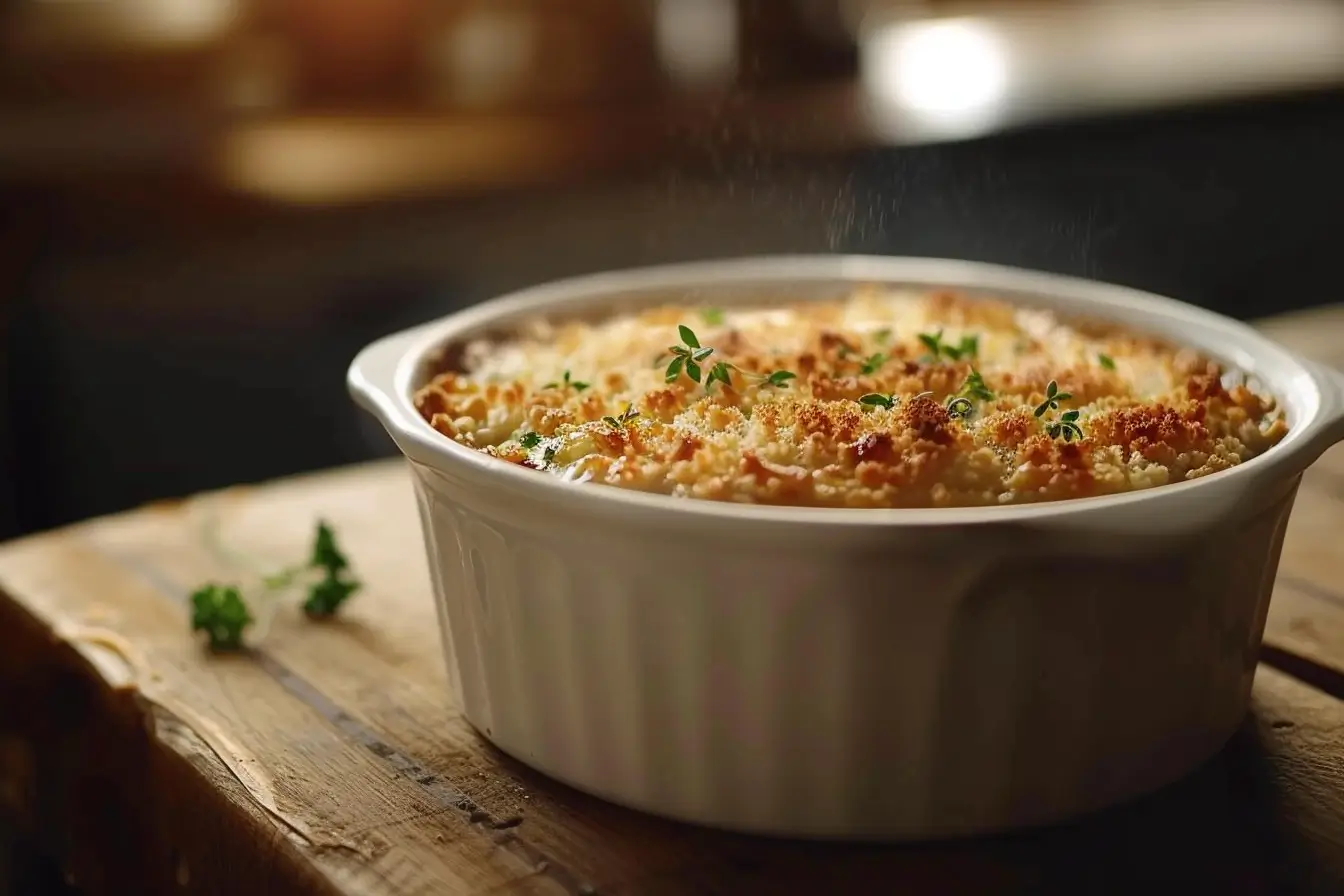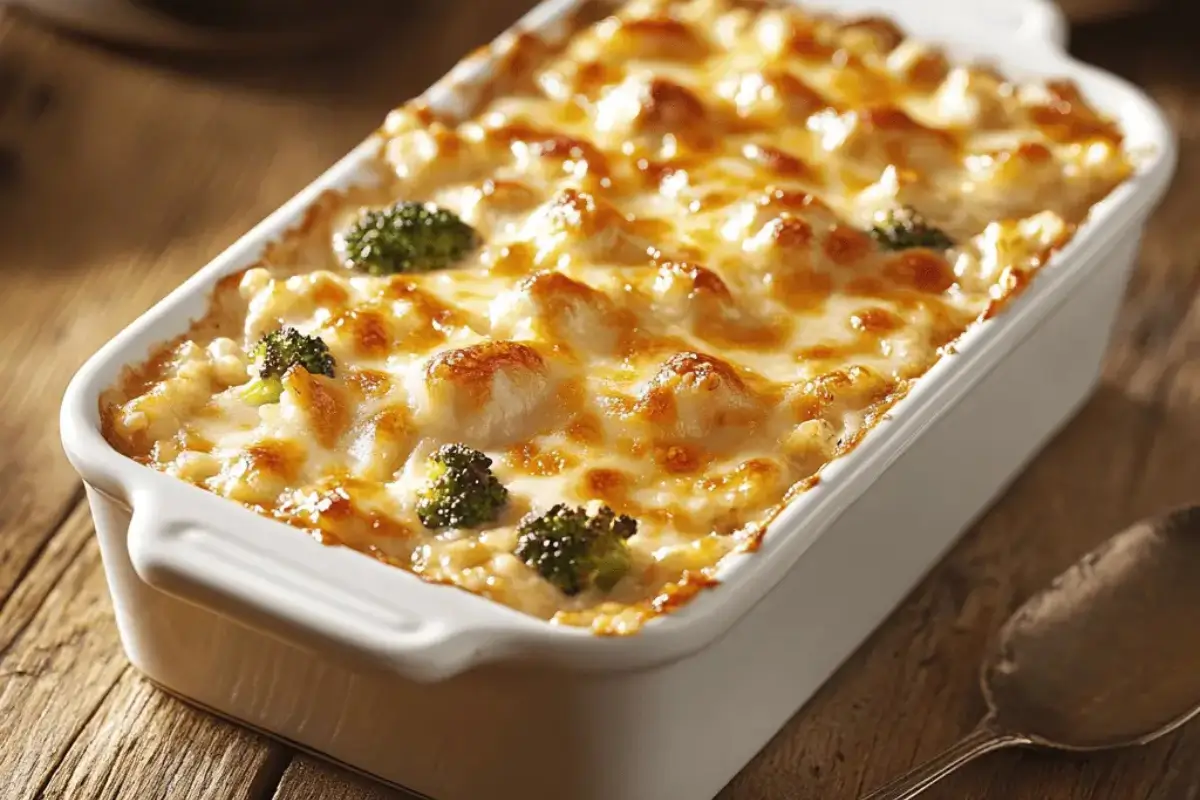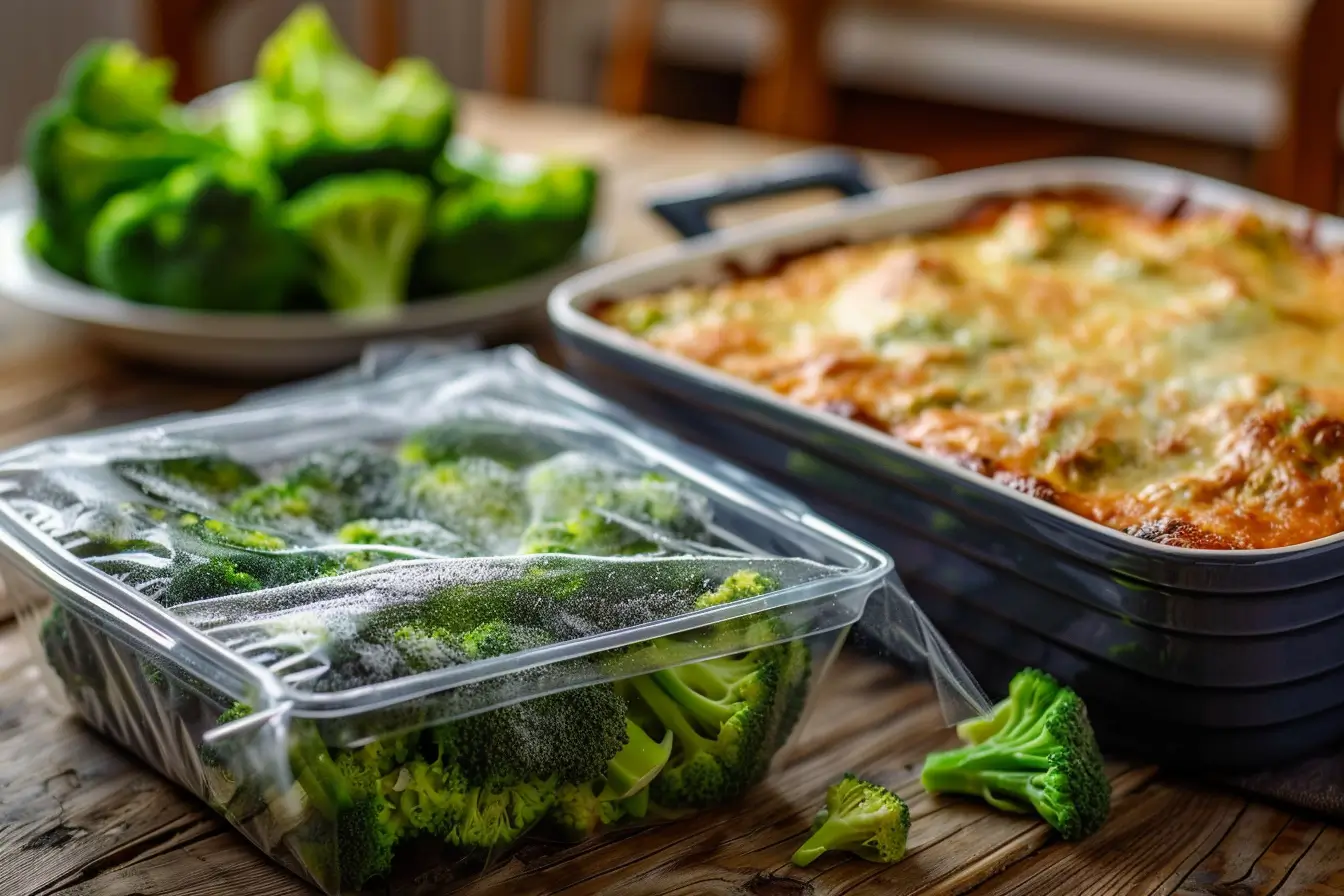Worry not! This guide delves deep into the secrets of achieving the perfect broccoli casserole texture, seamlessly answering the question, ‘how do you thicken broccoli casserole?’ In addition, it ensures every dish shines with perfection. Not only does this guide reveal the best methods for thickening broccoli casseroles, but it also guarantees a dish that’s consistently satisfying. Moreover, from identifying common pitfalls to mastering foolproof techniques, you’ll quickly become an expert at creating a thick and delicious casserole. Above all, this guide simplifies the process for every home cook. So, without further ado, let’s get started
What Makes a Good Broccoli Casserole?
First and foremost, learning how to thicken broccoli casserole is a critical skill. But a great casserole…
A great how do you thicken broccoli casserole isn’t just about flavor—it’s a harmony of taste, texture, and visual appeal. In addition, a creamy, rich consistency ensures each bite is satisfying. Furthermore, here’s what typically makes up this comforting dish:
- Fresh or frozen broccoli as the star ingredient.
- A blend of cheeses for that signature creamy texture.
- A crunchy topping, such as breadcrumbs or fried onions, for contrast.
- Binding agents like eggs or condensed soups to hold everything together.
Common Problems with How Do You Thicken Broccoli Casseroles
While broccoli casseroles are relatively straightforward, certain issues can arise. However, many of these problems are preventable:
- Watery consistency that ruins the texture.
- Overpowering flavors when the balance is off.
- Uneven cooking leading to undercooked broccoli or mushy results.
Why Is My Broccoli Casserole Watery?
One of the most frequent complaints is excess liquid. The reasons include:
- Overcooking the broccoli: Cooking broccoli too long releases water into the dish.
- Using frozen broccoli without draining: Frozen broccoli can contain excess moisture, which seeps out during cooking.
- Excessive liquid ingredients: Adding too much milk or broth can result in a runny casserole.
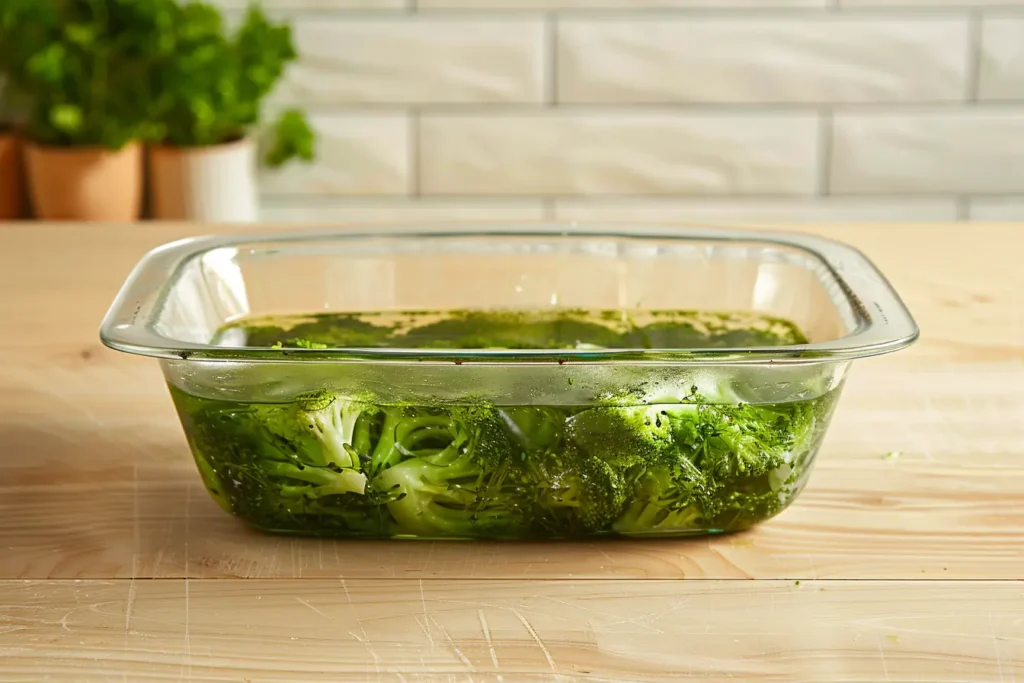
How to Make a How Do You Thicken Broccoli Casserole Thicker
When it comes to thickening casseroles, there are universal techniques that work across different recipes. Here’s how you can apply them:
Use Thickening Agents
- Flour or Cornstarch Slurry: Combine equal parts flour or cornstarch with cold water, then stir into the casserole mixture. This creates a velvety consistency.
- Cheese as a Thickener: Opt for cheese varieties like cheddar or mozzarella. These not only thicken but also enhance flavor.
- Cream of Soups: Canned soups like cream of mushroom or cream of chicken are excellent thickening agents.
Adjust Liquid Ingredients
- Reduce the amount of milk or broth used in the recipe.
- Swap thinner liquids with heavy cream or evaporated milk for a richer texture.
Baking Techniques to Remove Excess Liquid
Additionally, even the best-prepared casserole can benefit from baking adjustments. Therefore, understanding key baking techniques is essential:
Bake Without a Cover
- Additionally, covering the casserole traps steam, which can lead to watery results. Bake uncovered to let excess moisture evaporate.
Pre-Cook Broccoli Before Mixing
- Similarly, steam or sauté the broccoli to reduce its natural water content.
- Drain thoroughly before incorporating it into the casserole mixture.
How Do You Thicken Broccoli and Cheese Casseroles?
Meanwhile, a broccoli and cheese casserole brings its own set of thickening opportunities:
Choose the Right Cheese
- Velveeta or cream cheese melts smoothly, creating a thick and creamy texture.
- Hard cheeses like Parmesan can be added for extra thickness and a burst of flavor.
Add Binding Agents
- Whisk in an extra egg or two for additional structure and thickness.
- Use a small amount of potato flakes as a quick thickening hack.
Additional Flavor Boosters for How Do You Thicken Broccoli Casserole
If you want to elevate your how do you thicken broccoli casserole to the next level, consider these flavor-enhancing options:
Incorporate Herbs and Spices
- Add a pinch of nutmeg to the cream mixture for a subtle warmth.
- Use garlic powder, onion powder, or paprika for depth.
- Sprinkle fresh herbs like thyme, parsley, or chives for a burst of freshness.
Experiment with Toppings
- Try crushed pretzels for a salty crunch.
- Use seasoned panko breadcrumbs for an extra flavorful topping.
- Top with sliced almonds or pecans for a nutty twist.
Include Protein Options
For a more filling dish, add proteins such as:
- Diced cooked chicken or turkey.
- Cooked bacon bits for a smoky flavor.
- Canned tuna for a casserole-inspired take on tuna noodle dishes.
Creative Variations of How Do You Thicken Broccoli Casserole
For a fresh twist, try these unique variations of the classic how do you thicken broccoli casserole:
Broccoli and Rice Casserole
- Add cooked white rice or brown rice to the mixture for a heartier texture.
- Use wild rice for an earthy flavor that complements the broccoli.
Broccoli and Cauliflower Duo
- Replace half the broccoli with cauliflower florets for a balanced mix of flavors.
- Add a sprinkle of grated Gruyère cheese for a sophisticated touch.
Spicy Broccoli Casserole
- Mix in diced jalapeños or a dash of cayenne pepper for a spicy kick.
- Top with crushed spicy nacho chips instead of breadcrumbs for an unexpected twist.
What to Do If Casserole Is Too Watery?
If your how do you thicken broccoli casserole comes out runnier than expected, don’t worry. Instead, try these solutions:
Add Absorbent Ingredients
- Breadcrumbs or Crushed Crackers: Sprinkle these over the casserole and gently mix them in. They absorb excess liquid while adding texture.
- Mashed Potatoes: Mix in instant mashed potatoes to thicken the casserole instantly without altering the flavor.
Reheat and Reduce
- Place the casserole back in the oven uncovered. Bake at a low temperature to reduce excess moisture.
- Stir occasionally to ensure the liquid evenly evaporates.
Layering Ingredients Effectively
Preventing a watery casserole starts with layering and preparation.
Pre-Cook and Drain Vegetables
- Steam or blanch broccoli, then drain it thoroughly. Press lightly with a paper towel to remove any residual water.
- Avoid overcooking broccoli before adding it to the mixture.
Balance Wet and Dry Ingredients
- When using canned soups or sauces, balance them with drier components like rice or pasta.
- Add a thin layer of grated cheese or breadcrumbs between layers to trap excess moisture.
Adding More Binders Post-Cooking
If you need to salvage a watery casserole after cooking:
Whisk in a Thickening Paste
- Combine flour, cornstarch, or arrowroot powder with a bit of water. Stir this mixture into the casserole and bake for 10-15 minutes to activate.
Use Additional Eggs
- Whisk a couple of eggs and gently fold them into the casserole. Bake for a few minutes longer to set the mixture.
Recipe for Perfectly Thick Broccoli Casserole
Ingredients:
- 4 cups fresh broccoli florets (or 16 oz frozen broccoli, thawed and drained)
- 2 cups shredded cheddar cheese
- 1 cup cream of mushroom or chicken soup
- 1 cup sour cream or heavy cream
- ½ cup milk or evaporated milk (adjust for thickness)
- 2 large eggs, beaten
- 1 cup breadcrumbs or crushed crackers for topping
- 2 tbsp unsalted butter (for topping)
- Salt and pepper to taste
Instructions:
Pre-Cook the Broccoli
- Steam or blanch the broccoli for 2-3 minutes until slightly tender but not fully cooked.
- Drain thoroughly and pat dry with paper towels to remove any excess moisture.
Prepare the Mixture
- In a large mixing bowl, combine cream of mushroom/chicken soup, sour cream, and milk. Stir until smooth.
- Add the beaten eggs, shredded cheese, salt, and pepper. Mix well.
Assemble the Casserole
- Place the broccoli florets in a greased casserole dish.
- Pour the prepared mixture over the broccoli, ensuring even coverage.
Add the Topping
- In a small bowl, mix breadcrumbs or crushed crackers with melted butter.
- Sprinkle the topping evenly over the casserole.
Bake to Perfection
- Preheat the oven to 350°F (175°C).
- Bake uncovered for 25-30 minutes or until the casserole is bubbly and the topping is golden brown.
Ingredient Substitutions to Enhance Thickness
- Replace milk with evaporated milk or heavy cream for a richer, thicker consistency.
- Use gluten-free breadcrumbs or almond flour as a topping for a gluten-free option.
- Swap canned soup with a homemade roux (butter, flour, and milk mixture) for a fresher taste.
Tips for Reheating Broccoli Casserole
Proper reheating can ensure the casserole retains its thick, creamy texture.
Reheating in the Oven
- Preheat your oven to 325°F (165°C).
- Cover the casserole loosely with foil to prevent the topping from over-browning.
- Heat for 15-20 minutes or until warmed through.
Reheating in the Microwave
- Place a portion of the casserole in a microwave-safe dish.
- Cover with a microwave-safe lid or plate to trap heat.
- Heat on medium power in 1-minute intervals, stirring between intervals to ensure even heating.
Storing and Freezing Broccoli Casserole
For leftovers or meal prepping, storing the casserole properly is key:
Storing in the Refrigerator
- Allow the casserole to cool completely.
- Store in an airtight container for up to 3-4 days.
Freezing Broccoli Casserole
- Transfer the cooled casserole to a freezer-safe container or wrap it tightly in aluminum foil and plastic wrap.
- Freeze for up to 3 months.
- To reheat, thaw overnight in the refrigerator and follow reheating instructions above.
Frequently Asked Questions
How to make a casserole thicker?
To thicken a casserole, you can:
- Add a slurry made with flour or cornstarch and water.
- Use heavy cream or sour cream instead of milk.
- Incorporate cheese or canned soups as natural thickeners.
- Bake uncovered to let excess moisture evaporate.
Why is my how do you thicken broccoli casserole watery?
A watery how do you thicken broccoli casserole may result from:
- Using frozen broccoli without draining it thoroughly.
- Overcooking broccoli, causing it to release water into the dish.
- Adding too much milk or liquid ingredients.
How do you thicken broccoli and cheese?
For broccoli and cheese casseroles, try:
- Using thicker cheeses like cream cheese or Velveeta.
- Adding eggs as a binder to create structure.
- Mixing in flour or potato flakes for extra thickness.
What to do if casserole is too watery?
If the casserole turns out watery, you can:
- Mix in breadcrumbs or crushed crackers to absorb excess liquid.
- Bake the dish uncovered for a few extra minutes.
- Stir in a thickening paste made with flour or cornstarch.
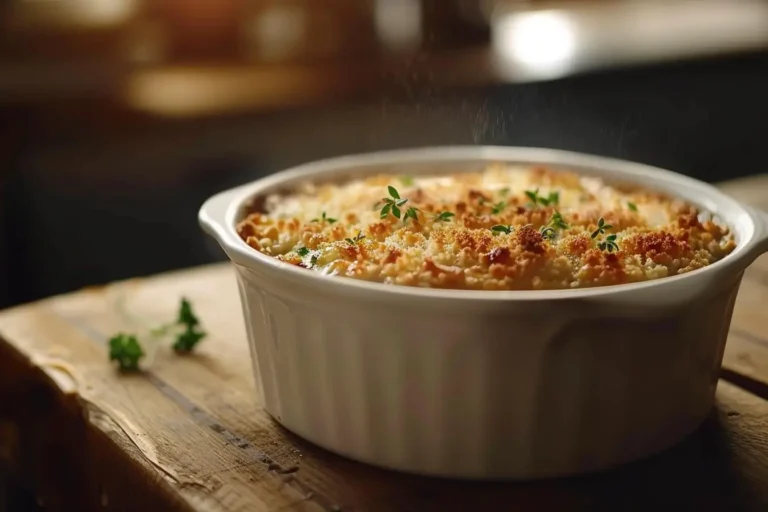
Perfectly Thick Broccoli Casserole
A creamy and hearty broccoli casserole with a crunchy topping, perfect for any occasion.
- Total Time: 45 minutes
Ingredients
– 4 cups fresh broccoli florets, steamed
– 1 cup cheddar cheese, shredded
– 1/2 cup mozzarella cheese, shredded
– 1 cup sour cream
– 1 can (10.5 oz) cream of mushroom soup
– 1/4 cup mayonnaise
– 1/2 teaspoon garlic powder
– 1/4 teaspoon black pepper
– 1/4 teaspoon salt
– 1 cup breadcrumbs
– 2 tablespoons melted butter
Instructions
- – Preheat your oven to 375°F (190°C). Grease a 9×13-inch baking dish.
- – In a large mixing bowl, combine steamed broccoli, cheddar cheese, mozzarella cheese, sour cream, cream of mushroom soup, mayonnaise, garlic powder, black pepper, and salt. Mix well.
- – Transfer the mixture to the prepared baking dish, spreading it out evenly.
- – In a small bowl, combine breadcrumbs with melted butter. Sprinkle this mixture evenly over the casserole.
- – Bake for 25-30 minutes, or until the topping is golden brown and the casserole is bubbling around the edges.
- – Let it cool for 5 minutes before serving.
- Prep Time: 15 minutes
- Cook Time: 30 minutes
Nutrition
- Serving Size: 6
- Calories: 320 per serving
Serving Suggestions for How Do You Thicken Broccoli Casserole
A how do you thicken broccoli casserole pairs wonderfully with many dishes. Here are a few serving ideas:
- Serve alongside roasted chicken or turkey for a comforting family dinner.
- Pair with a crisp garden salad and garlic bread for a well-rounded meal.
- Use as a side dish at potlucks or holiday gatherings—it’s always a crowd-pleaser!
Make-Ahead Tips for How Do You Thicken Broccoli Casserole
Broccoli casserole is an excellent dish to prepare ahead of time. Here’s how:
- Assemble the casserole as instructed but don’t bake it. Cover tightly and refrigerate for up to 24 hours.
- To freeze, assemble the casserole in a disposable aluminum tray. Cover with foil and freeze for up to 3 months.
- Bake directly from the refrigerator or freezer, adjusting the cooking time as needed.
Conclusion
A thick and creamy how do you thicken broccoli casserole is more than just a side dish—it’s a comforting classic that brings people together. To achieve the perfect texture, you can use techniques like incorporating thickening agents, adjusting liquids, and baking uncovered. Additionally, understanding how to prevent and fix watery casseroles gives you the confidence to tackle any recipe with ease.
Moreover, don’t be afraid to experiment with ingredients such as different cheeses, breadcrumbs, or even gluten-free alternatives to suit your preferences. After all, cooking is about personalization, and with these tips, your how do you thicken broccoli casserole will always stand out on the dinner table.
Finally, what’s your favorite way to thicken a how do you thicken broccoli casserole? Feel free to share your tips or questions in the comments—I’d love to hear from you!”
This version incorporates additional transition words like to achieve, additionally, moreover, after all, and finally for smoother flow and improved sentence connectivity
Looking for more comforting casserole recipes? Check out our guide to Chicken Broccoli Pasta Casserole Recipe for another delicious option.


